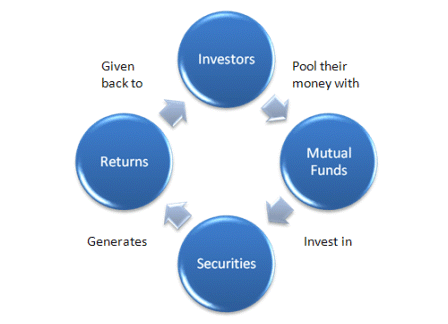There are more than 12,000 financial investment funds currently. Among them are the Mutual fund investments, which belong to the category of Undertakings for Collective Investment in Transferable Securities (UCITS).
When you want to invest, there is, on the one hand, the bank investment which gives a rather low return, but without risk and on the other hand, more risky financial investments with a good return. How does a MFI work? What is the taxation on the performance of a MFI? Here is a full article on mutual funds.
What is an MFI?
In order to grasp the subject of MFIs as a whole, it is important to come back to the definition of these and their functioning.
Mutual funds (MFI): definition
MFI: pooling of capital
The mutual fund consists of a pooling of capital invested by holders of financial securities (investors). A security holder is a person who has invested in one or more MFIs and who, in return, holds a share (pro rata of the securities). Security holders are co-owners of the fund.
There are several classes:
Monetary: the risk is minimal
Shareholder: for a Mutual fund investment of this class, 60% in action and 40% free. The risks are significant, but the return is high.
Bond: few risks with a so-called modest but more regular performance.
Alternative management: the risks are high.
With formula: there are the guarantee funds (without risk of loss), the funds known as protected with a limited risk and the funds with promises (amount indicated in advance).
Streamlined: these are mainly life insurance contracts that have linearity in their management and in their performance.
How an MFI works
It is a company that manages the fund. Each holder of securities invested and it is the company which will decide where to place this money according to the objectives of the fund. An MFI does not have a legal personality; each co-owner engages his responsibility up to his invested capital, neither more nor less.
There are different types of MFI:
Company MFI (MFIE):these funds are intended for employees who wish to invest in their business. It is an employee participation in the results of the company.
Risk MFI (MFIR):as its name suggests, it is for so-called “risk” products with a minimum mandatory investment of 50% in European stocks not listed on the stock exchange. In return for the risks incurred, there is a tax advantage on these shares if they are kept for at least 5 years. Advantage which consists of a tax exemption (social security contributions remain compulsory). This type of MFI is now called FPCI (Professional Capital Investment Fund).
MFI in innovation (MFII): the fund must be invested at least 60% in companies not listed on the stock exchange, in an innovation sector (high-tech sector) with high capital gains. This is for example the case of the Internet, telecommunications or even electronics. It is also a risk fund which gives the right to a tax reduction of 28% of the amount of capital invested with a ceiling (€ 3,000 for a single person, € 6,000 for a couple). It will, of course, be necessary to keep this investment for at least 5 years.
Real Estate Investment Funds: in shares only. They can be managed by distributors, custodians or management companies.
Futures market mutual fund (FCIMT): it is the same principle as a MFI to which two additional constraints are added. 50% must be held in cash and be a formula fund with the amount of the fund determined in advance.
Taxation and MFI calculation
For the accounting of a MFI, it is necessary to differentiate income from capital gains. In fact, to be able to file your income tax return, you will not put these two things in the same box.
Since January 1, 2018, the taxation of financial investments has changed. The 2018 Finance Law introduced the single flat-rate levy (PFU) which brings a levy up to 30% including 12.8% tax and 17.2% social security levy. This fixed deduction is calculated on the capital gains recorded on the sale of capital shares. It is also calculated when you are going to declare your income from securities and movable capital.
Did you know?
- You can choose the PFU or the progressive tax scale for your income tax return. It must be requested before the end of the year preceding the declaration. This choice is correlated with your income. There are tax details for each type of mutual fund.
- To calculate and know the performance of your capital, simply subtract the assets from the liabilities.
- The liabilities are equivalent to the number of shares of security holders and the assets are all that relates to financial instruments, the market, etc. To make the calculation, the assets are frozen through the MFI’s portfolio. This gives the value of the asset. By dividing the value of the assets by the number of shares of security holders, you will have the net asset value of the fund.
MFI or Investment Company with variable capital (SICAV)?
It is important to differentiate between a SICAV and a MFI thanks to their definition:
SICAV: SociétéAnonyme (SA), a legal person managed by shareholders with a board of directors. Each shareholder has the right to vote. For a SICAV to be created, a minimum capital of 7.5 million euros is required.
MFI: it is a little on the same principle as an SARL since each holder of securities is entitled to a number of shares proportional to its investment capital. To create a fund, the entry ticket amounts to € 400,000.
When we already look at these two definitions, we can see that the legal status is not the same. Then there is a difference in the risks taken and the nature of the investors. For a MFI, you have a more lucrative return with greater risks than for a SICAV. Only the capital is limited.
What should be remembered is that these are collective investment undertakings for transferable securities (UCITS) which operate almost similarly with differences in status. To make your choice, you can refer to the document that was sent to you during your investment search: the Key Investor Information Document (KIID). It is this document which will detail all the data concerning the fund in question: performance, strategy, risks, costs, etc.
Good to know: SICAVs are often more suitable for so-called experienced investors because they are decision-makers, which is not the case for a MFI. Find out more.
Frequently Asked Questions
How to translate MFI in English?
We could translate this by mutual funds. It is the same translation for a SICAV or a UCITS. Indeed, our French acronyms do not exist as is in English. It will therefore be necessary to explain in more detail what an MFI is to make the difference with the others.
How to subscribe to a MFI?
To subscribe, simply go to an online banking establishment, with a broker or an insurer to make your request. In exchange you will receive the KIID which will give you an idea of the risks and costs incurred. Then it only remains to choose.





